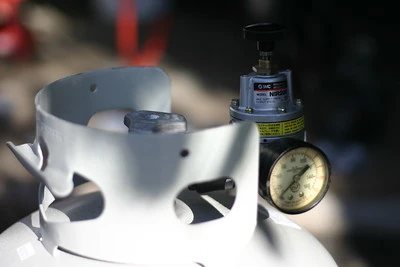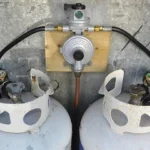12 Ways to Know if Lpg Regulator Is Broken (How to Suspect)


1. Hissing Sound (Gas Leak)
If you hear a faint hissing sound around the regulator, this could indicate a gas leak. Even if you can’t smell gas, this sound can signal that something’s wrong. Unusual noises are a good reason to check for leaks or call a technician.
2. Weak Flame or Difficulty Igniting
A sign of a broken regulator is when your stove or grill flame is much weaker than usual, or you’re having trouble getting it to light up. This happens because the gas isn’t being properly regulated, leading to low pressure.
3. Yellow or Orange Flames
The normal color of an LPG flame is blue. If you notice yellow or orange flames, it could be due to an incorrect gas-to-air mixture, a sign that your regulator isn’t doing its job correctly. This can also indicate incomplete combustion, which may lead to carbon monoxide risks.
4. Inconsistent Flame Height
If the flame keeps going up and down without you adjusting the setting, it might mean that the regulator isn’t controlling the gas flow properly. This inconsistency can become dangerous if not fixed.
5. Unusual Smell Near the Regulator
Even if there’s no obvious gas leak, a faint rotten-egg smell could be coming from a faulty regulator. This odor is from the added odorant in LPG, which makes leaks detectable.
6. Sudden Gas Smell After Turning Off the Appliance
If you notice the smell of gas after turning off your appliance, it could mean the regulator isn’t sealing off the gas flow completely when not in use. This is a less obvious but potentially dangerous sign.
7. Frost Buildup on Regulator
Sometimes, frost can form on the regulator if it’s malfunctioning. This can happen due to excessive pressure or a faulty diaphragm inside the regulator, and it affects the gas flow.
8. Appliance Shuts Off Automatically
If your LPG-powered appliances (stove, heater, etc.) shut off without warning, it might mean that the regulator is failing to supply gas at a steady rate, causing safety shut-offs to engage.
9. Overheating Regulator
A broken regulator might get too hot to the touch because it’s overworking or there’s too much pressure inside. This is a sign that something is wrong, even though you may not associate heat with a regulator issue.
10. High-Pitched Whistling Noise
Sometimes, when there’s too much pressure in the regulator, you might hear a high-pitched whistling sound. This is different from the typical hissing and indicates that the pressure inside is not being controlled properly.
11. Gas Appliances Take Longer to Heat Up
If it takes longer than usual to heat up your gas stove, oven, or heater, this could point to a reduction in gas flow due to a malfunctioning regulator.
12. Visible Damage
Check for cracks, rust, or physical damage on the regulator. While this seems obvious, sometimes the damage isn’t easily noticeable, and it could be a sign that the regulator is worn out and no longer safe.
Each of these signs can indicate that your LPG regulator is broken or failing. If you notice any of them, it’s important to replace or have the regulator serviced to avoid potential hazards.
What to Do If You Suspect a Broken Regulator
Immediate Action Steps
- Turn off the gas supply right away:
If you suspect your regulator is broken, immediately turn off the gas valve, which is usually located near the LPG tank. This is crucial because a faulty regulator can cause gas to leak, leading to potential fire hazards or explosions. Turning off the gas stops the flow, preventing any dangerous situations while you figure out what’s wrong. - Call a professional:
After turning off the gas, don’t try to fix the problem yourself. Gas systems are complex, and trying to fix the regulator on your own can be dangerous if you don’t have the right tools or knowledge. A certified technician will have the expertise to safely inspect and repair the issue. They’ll check for leaks, test the gas pressure, and make sure everything is functioning as it should.
Regular Inspections
- Schedule regular checks:
Just like you regularly maintain your car, it’s important to check your LPG system too. Over time, regulators can wear out, especially if exposed to the elements. By having a professional check your system on a yearly basis or as recommended, they can catch small issues before they turn into bigger, more expensive, or dangerous problems. Regular maintenance ensures your regulator and gas system stay in good working condition. - Especially if the regulator is old:
Regulators don’t last forever. If yours has been in use for many years, it’s more likely to wear out or malfunction. If it’s over 10 years old, or you’ve noticed any issues before, it’s a good idea to schedule an inspection or consider replacing it. An old or worn-out regulator is more prone to leaks or not regulating gas properly, which can be unsafe.
Replace It If You Have a Broken Regulator
If you find out your regulator is broken, the safest thing to do is replace it as soon as possible. A broken regulator can cause gas leaks or make your appliances work poorly. Getting a new one will ensure your gas system is safe and works properly. Don’t wait too long—using a faulty regulator can lead to bigger, more dangerous problems down the road. Always make sure a professional handles the replacement for safety.
Why Replacing a Broken Regulator Is Important
A faulty regulator can lead to a range of problems, from small annoyances like weak flames to serious safety hazards like gas leaks. Replacing it ensures that your gas system works as it should and keeps you and your family safe. Gas leaks can cause fires or explosions, so it’s not something you want to risk.
How to Replace It
When it’s time to replace the regulator, always call a professional. They’ll know the correct type and size of regulator for your system, and they’ll make sure it’s installed correctly. Installing it yourself could lead to mistakes that may cause gas leaks or other issues.
Prevent Future Problems
After getting your new regulator, it’s a good idea to keep an eye on how it’s working. Regular maintenance, such as yearly inspections, will help prevent future issues. This way, you won’t have to worry about unexpected breakdowns or safety concerns.
Replacing a broken regulator is a simple step that can save you from bigger problems later.
If Your Regulator Is About To Fail, Better To Replace It As Well
If you notice any signs that your regulator might be failing—like weak flames, strange sounds, or gas smells—it’s better to replace it before it fully breaks down. Waiting until it completely fails could lead to gas leaks or other serious problems. Replacing it early ensures your gas system keeps running safely and smoothly, without any surprises. It’s always safer (and cheaper) to fix the problem before it becomes an emergency.
Why Replacing a Failing Regulator Early Is a Good Idea
When a regulator starts showing signs of wear or malfunction, it’s a warning that something isn’t right. By replacing it early, you’re avoiding the risk of a full failure, which could cause gas leaks or damage your appliances. Plus, if you replace it early, you’ll avoid the inconvenience of your gas-powered appliances suddenly stopping working when you need them the most.
Signs Your Regulator Is About to Fail
- Inconsistent Flame or Pressure: If your flame keeps getting weaker or stronger without you changing the settings, it’s a sign that the regulator is struggling.
- Unusual Noises: If you hear hissing, popping, or whistling sounds around the regulator, this could mean it’s about to fail.
- Gas Smell: If there’s a slight gas smell around the regulator, even when everything is off, that’s a clear sign the regulator is not sealing properly.
Avoid Bigger Problems by Replacing Early
Replacing the regulator before it fully fails helps you avoid dangerous situations, like gas leaks or poor performance from your appliances. It also saves you from costly repairs or damage that might happen if a failing regulator goes unnoticed. Preventative action is always the safer and smarter route when it comes to gas systems.
By acting early, you ensure your system stays safe and you avoid the hassle of emergency replacements or unexpected breakdowns.
Don’t Fix a Broken Regulator
If your LPG regulator is broken, it’s important not to attempt fixing it yourself. Regulators control the flow and pressure of gas from your tank to your appliances, and they are designed with precise engineering to do this safely. Once they break or malfunction, it’s hard to repair them to their original condition, and any mistakes could lead to gas leaks or serious safety hazards.
Why You Shouldn’t Fix It Yourself
LPG regulators have complex components, including springs, diaphragms, and seals that manage gas pressure. These parts work together to ensure the gas flow stays safe and consistent. If one part is damaged, the whole system can become unreliable. Trying to fix it yourself without the right tools or knowledge can cause even more damage or lead to improper sealing, which could allow gas to escape.
Potential Dangers of DIY Fixes
- Gas Leaks: A faulty repair might result in gas leaking from the regulator, which can lead to fire or explosion risks.
- Incorrect Gas Pressure: If you try to fix it and the pressure isn’t regulated properly, your appliances may not get the right amount of gas. This could cause weak flames, poor performance, or even damage to your stove, heater, or grill.
- Safety Mechanisms: Modern regulators often have built-in safety features that prevent accidents. If these are damaged, your system might not shut off the gas properly in the event of a leak.
Replacement Is the Safe Choice
Instead of fixing a broken regulator, it’s much safer and more reliable to replace it with a new one. A certified professional will install it correctly and ensure the gas pressure is regulated according to safety standards. This guarantees your gas system works efficiently without any risk of leaks or malfunctions. Trying to fix a broken regulator yourself can cost more in the long run if something goes wrong.
In short, don’t take chances with your safety—when a regulator is broken, always opt for a professional replacement.
To Make a Conclusion
In summary, recognizing the signs of a broken LPG regulator is crucial for your safety and the smooth operation of your gas appliances. Look out for obvious signs like strange sounds (hissing or whistling), weak or flickering flames, and unusual gas smells. Also, be aware of less obvious signs such as inconsistent heating, frost buildup, or your appliances suddenly shutting off.
If you notice any of these warning signs, it’s important to act quickly. Turning off the gas and calling a professional can prevent dangerous gas leaks or malfunctions. Don’t forget to schedule regular inspections, especially if your regulator is old. Replacing a faulty or failing regulator early ensures your system stays safe and reliable.
Being proactive about your LPG system keeps you safe and prevents bigger problems in the long run.
Image source: Jack Carrozzo (Flickr)

Mike is an experienced propane technician with over 15 years of professional experience in the field. He has dedicated his career to helping customers with their propane needs, from installation to maintenance and repair. Together with Jeremy, he co-founded this website to provide useful information and guidance to customers seeking reliable propane services.
Mike is an experienced propane technician with over 15 years of professional experience in the field. He has dedicated his career to helping customers with their propane needs, from installation to maintenance and repair. Together with Jeremy, he co-founded this website to provide useful information and guidance to customers seeking reliable propane services.
View All Articles
